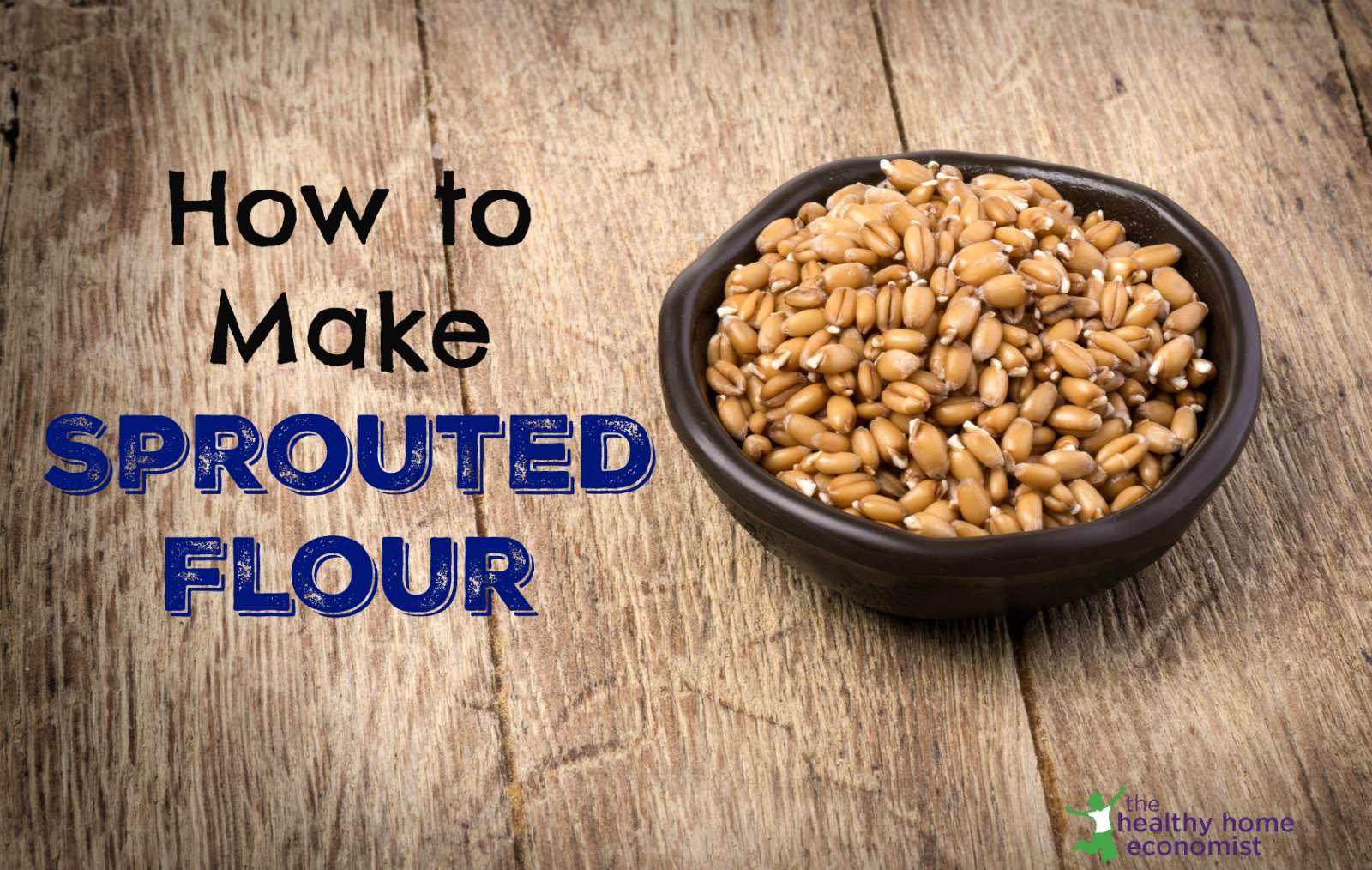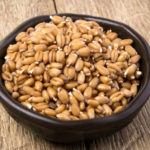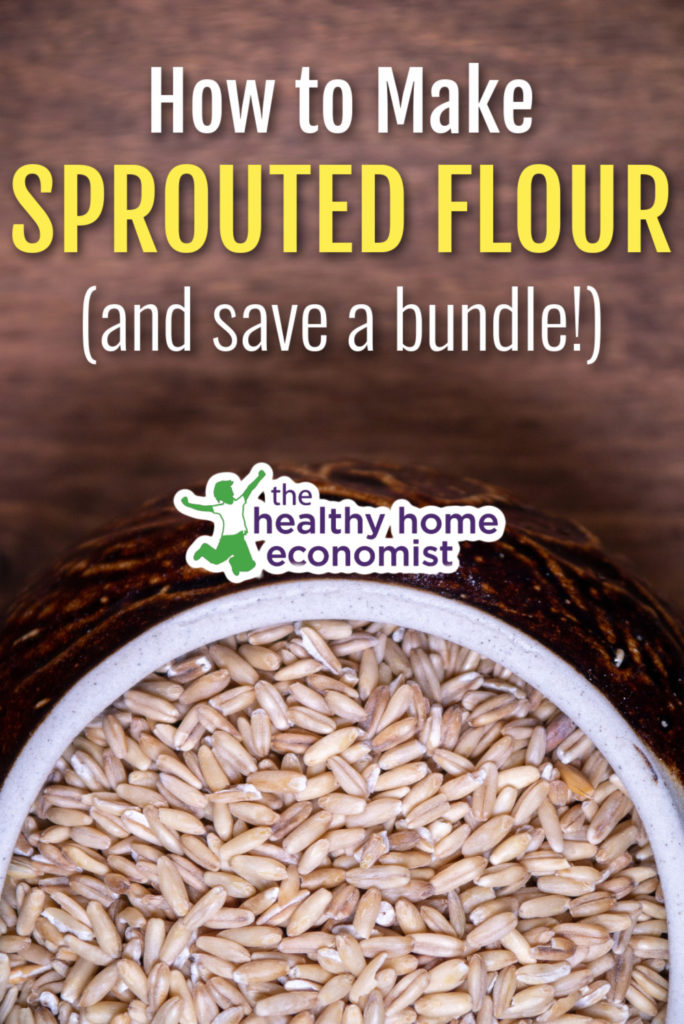How to make sprouted flour yourself at home by sprouting the grain of your choice for more nutritious, filling, and digestible baked goods. It saves a bundle too!

Sprouted flour made from freshly ground, germinated grain is one of the 3 ways traditional societies used to prepare their grains before eating.
These careful methods are necessary in order to eliminate anti-nutrients such as phytic acid and lectins. They also help neutralize toxins and break down difficult to digest proteins such as gluten. In addition, the process optimizes digestibility to allow maximum absorption of nutrients.
Unfortunately, sprouting as a traditionally inspired practice has been lost in favor of modern cooking techniques. Today, home chefs value speed and convenience over nutrient density and digestibility!
Many consumers are returning to these wise and ancestral preparation methods, especially as allergies and intolerances to grains continue to explode across the industrialized world.
It is amazing to me how many folks label themselves as “gluten intolerant”. If they only realized how simple cooking techniques will easily break down the gluten and possibly allow them to enjoy wheat again!
Benefits of Sprouted Flour
Sprouted flour is substantially more nutritious than unsprouted. For example, vitamin C is produced by germinating grain, but it is absent in the unsprouted form. Vitamin B content is increased dramatically by sprouting as are carotenes, precursors to Vitamin A.
Sprouting inactivates the irritating substances in the hull of the grain as well. These inhibitors (phytic acid) have the potential to neutralize enzymes in the digestive tract. These substances also block the uptake of important minerals like zinc.
Hence, the germination process exponentially increases the ease of digestion and metabolism of nutrients! It reduces the chances of indigestion, acid reflux, and bloating too.
From a practical point of view, you feel full more quickly and stay satisfied longer when sprouted foods are consumed. The increased nutrition in each bite is what makes this possible.
Germination Inactivates Aflatoxins
Much media attention has brought attention to the problem of aflatoxins in grains. These substances are potent carcinogens and are present in high quantities in highly processed foods such as crackers, cookies, chips, and cereals.
Sprouting inactivates aflatoxins, which is just another reason to follow the wisdom of traditional peoples in grain preparation!
Less Expensive
While there are many places nowadays to buy sprouted flour, it can be expensive, typically running $5-10/pound depending on the type of grain you seek.
Another option is to buy grain kernels already sprouted and grind into fresh flour yourself. This costs about the same as buying sprouted flour.
On the other hand, buying the grain of your choice in bulk, sprouting the kernels yourself, and then grinding into flour costs roughly half this amount!
More Nutritious
Not only is it cheaper, but homemade sprouted flour is more nutritious too.
Once grain is sprouted and/or ground into flour, the protective substances in the hull are deactivated. This results in a rapid loss of nutritional value…even faster than unsprouted flour. There is also an increased risk of rancidity once the delicate polyunsaturated fats in the grain are exposed to air and light post grinding.
Thus, making germinated flour yourself will result in a fresher product with most of the nutrition preserved. It is time well spent.
Equipment for Sprouting Grain Kernels to Make Flour
The first item you need to sprout grain is a glass container with a screen lid and a stand for easy drainage/airflow (like this one).
Alternatively, many health food stores sell sprouting jars, but they are sometimes pricey.
If the budget is tight, you can make a DIY sprouting jar yourself using a large, wide-mouth mason jar and a clean pair of pantyhose cut to fit about an inch or two wider than the lid. Fasten with a rubber band and you’re all set!
Note that buying organic grain is best as nonorganic sources are sometimes irradiated and will fail to sprout.
While it doesn’t take much effort, germinating grain does take a bit of time to allow Mother Nature to do her work. Thus, it is wise to plan for large batches at a time so that you only have to sprout your grains once or twice a season!
Recipes Using Sprouted Flour
Once you’ve successfully made your first batch of sprouted flour, try one or more of these recipes to enjoy the delicious fruits of your labor!
- Sprouted Brownies
- Belgian Sprouted Waffles
- Peanut Butter Cookies
- Traditional Sprouted Stuffing
- Sprouted Flour Pizza Crust
- Sprouted Crackers

Homemade Sprouted Flour
How to make sprouted flour at home by sprouting the grain of your choice for baked goods that are more digestible, filling, and nutritious.
Ingredients
- 2 cups whole grain kernels preferably organic
- filtered water
- sprouting jar
Instructions
-
Fill sprouting jar no more than half full of grain. Rinse the kernels several times with filtered water until they are completely wet.
-
Fill the jar until almost full with water and let the berries soak overnight. The next morning, tip the jar and drain out the water using the screen lid to prevent the berries from spilling out. Rinse the wheat one more time and then invert the jar and let it sit at an angle to facilitate draining and allowing the circulation of air. I use my grain grinder as a support for the jar so that the draining occurs right over the kitchen sink.
-
Every few hours, rinse the kernels again and reset the jar in the draining position. Anywhere from a few hours to a couple of days (depending on the time of year and warmth/humidity in your home), small white buds will appear on the ends of each grain kernel. Immediately proceed to the next step, as letting the sprouts grow too large reduces the amount of flour you will produce after grinding.

-
Pour the sprouted kernels into baking pans and place in a dehydrator or a warm oven (150 F/ 65 C) for about 24 hours until fully dried. Keep a shallow depth for the kernels in the pans to ensure quick drying. Take care not to go over 150 F/ 65 C, else you will toast the flour.
-
After the sprouted grains are dry, store them in an airtight container in the refrigerator, or grind immediately and then freeze the sprouted flour.
-
Use sprouted flour just like you would use regular flour in your favorite baking recipes, substituting 1:1.









I am not familiar with a Nutrimill but my very basic Champion grinder grinds sprouted flour kernels just fine. I have recently come across some new research by Rami Nagel which suggests that while wonderful, sprouting does not inactivate phytic acid and other antinutrients as much as previously though. If you want to sprout, it might be best to also soak or sourleaven the dough as well.
When you sprout, you want the sprout to be just emerging from the kernel. If you let it get too long, the starch will be used up and you won’t end up with much flour when you grind it.
Please see my video on this to see how long the sprouts should be.
Also, My blog on Whole Grains Cause Cavities? explores whether sprouting alone is effective in eliminating phytic acid in more depth.
Sarah,
I'm not sure if you will get this comment as the post is several months old. There is quite a bit of conflicting information about sprouting flour. Essential Eating claims that most home sprouted flour is drowned. Which doesn't make sense if it sprouts, as a growing sprout is considered a living food. Also there is The Falling Number Test, which I am not sure how it applies to home sprouters. Is it implying that you would need as a home sprouter to let your sprouts grow longer than just a bud to ensure that there is sufficiet enzyme activity and that phytic acid is broken down? I have read all over the web that anywhere from buds to one inch sprouts are sufficient to reduce intolerance to grains & phytic acid. Is this a individual trial and error to see what works for any given individual? Or are you aware of more solid evidence that specifically states at what point of sprouting phytic acid and gluten are inhibited and there fore the grain is now a living food nutritious food. I have sproued to buds and as long as one half of an inch. The longer the sprout the harder it seems for my NutriMill to grind, even thought I am quite sure the sprouts are sufficiently dehydrated, longer sprouts also seems to behave differently in baking which as you know can be frustrating. I would like to provide my family with the most nutritious option possible and am a little uncertain on this. Thank You.
great post!
You do not need to soak sprouted flour. Sprouted flour already has the gluten and antinutrients broken down so soaking would be overkill. Only soak unsprouted flour. I have only ever soaked wheat or spelt flour so do not have experience soaking other flours.
I think I read a recipe a while ago that soaked flour for about 24 hours before using in recipe. What is your opinion on soaking the flour? I am about to do it with a mixture of bleached flour and brown rice flour? Is this beneficial? If so, are all grain flours OK to soak?
Please forgive me for posting so many times on your site, but now I've just read your advice that we should not make yeasted breads with the sprouted flour, or that we should ferment it instead. I was excited to be getting such wonderful bread with my sprouted flour because I have not been successful with fermented breads. Also, I had been reading on the site of To Your Health who makes and sells sprouted flours that we can use sprouted flour just like unsprouted flour, which I have been doing. I don't want to sound argumentative, but gluten does develop in my bread, or SOMEthing is going on in there because my bread rises all the way to the cover of my bread machine, and is very wonderful-tasting, fluffy and light. Maybe I'm misunderstanding your statement: "Yeast is fine to use with sprouted flour if you want on perfecting that process". I didn't have to perfect any process, my bread turned out GREAT the very first time. So apparently you must be saying that even though the bread looks and tastes good, it's not a good idea to use sprouted flour for bread-making? I was thinking of using it for sourdough, but again, I have been trying to make sourdough bread and it makes bricks. Don't really want to waste my good sprouted flour on bricks 🙂
I haven't seen answers to any of my questions yet, probably because I was on some older blogs and maybe you haven't seen them yet; but I sure would love to hear your take on some of these issues. I've just recently discovered your site and love it. Thank you for all your work so that people like me can benefit from it.
Hello Naomi, I read your comments about making bread with sprouted flour, and was wondering if you would be interested in sharing your recipe with me. I have a friend in another state that is trying along with me to learn to sprout and to make the bread with the sprouted flour. We share our comments over the phone, though we rarely see each other since we live so far apart. I told her about your comments and she suggested that I ask you for your recipe.
Thanks , Linda
Hi Naomi, I think perhaps there was a misunderstanding. It is fine to use yeast for bread made with sprouted flour .. I just have not had good success making a very good bread this way, but if you are that is great! I think I said not to use yeast in UNsprouted flour bread as this would cause a quick rise and the gluten would not be broken down sufficiently. If you want to make bread with unsprouted flour, then sourdough or soaking are the methods to be used there. Hope that makes sense. Glad you are enjoying the blog!
Hi Sarah, I have just discovered the health benefits of soaking and sprouting grains! I am excited to try your methods as buying sprouted flour is killing my budget! 😉 Also, just FYI, Becker's coop web address has changed… it is now
Thanks for all the great info, I am looking forward to eating grains again and taking better care of my family!
Thank you for sharing how to make sprouted flour at home. I have now done it twice and found it to be easy. It helps that I already had a grain grinder and a dehydrator. The biscuits and pancakes have been wonderful.
Thanks for the kind words, Holly, It is stories like yours that keep me blogging!